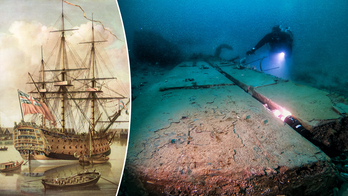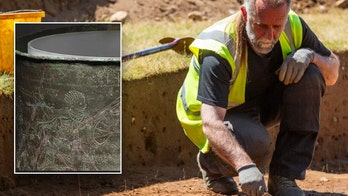
THREAD: iron age treasure trove unveiling
LifeLine™ Media threads use our sophisticated algorithms to construct a thread around any topic you want, providing you with a detailed timeline, analysis, and related articles.


LOST TREASURE Ship Recovery Discovery Sparks Hope and Awe Off Ireland’s Coast
— Underwater experts say they have found the RECOVERY, a British treasure ship lost off Wexford, Ireland, in 1787. Marine specialist Edmond O’Byrne’s team made the find and shared details with Pen News. The ship vanished more than 200 years ago while carrying valuable cargo gathered by James Caulfeild and rare art owned by banker John LaTouche.
The RECOVERY was packed with marble, bronze, and other treasures from a European tour before it sank 85 miles south of Dublin. It had just stopped in London after leaving Italy. Six people died in the wreck, including the captain and two of his sons.
This discovery could shine a light on a forgotten piece of British and Irish history. The team is still searching the site for more proof to confirm that this is truly the lost treasure ship RECOVERY.

18TH-CENTURY TREASURE Ship Discovery Stirs Emotions OFF Ireland Coast
— A team of underwater archaeologists says they have found the RECOVERY, a British treasure ship lost in 1787 near Wexford, Ireland. Marine expert Edmond O’Byrne shared that his group uncovered the wreck, which disappeared over 200 years ago.
The RECOVERY carried marble, bronze, rare art, and natural wonders collected by James Caulfeild and John LaTouche — one of Ireland’s richest bankers at that time. The ship sank 85 miles south of Dublin after a stop in London on its way from Italy.
Six lives were lost in the sinking, including the captain and two of his sons. This find could reveal more about a gripping chapter from British maritime history.

LOST TREASURE Ship Discovery Stirs Hope And Hearts OFF Ireland Coast
— A team of underwater archaeologists says they may have found the RECOVERY, a British treasure ship lost in 1787 near Wexford, Ireland. Marine expert Edmond O’Byrne’s crew believes the wreck matches the long-missing vessel that vanished more than two centuries ago.
The RECOVERY carried priceless marble, bronze, rare art, and natural wonders collected by James Caulfeild and wealthy banker John LaTouche during their travels across Europe. The ship sank 85 miles south of Dublin after a stop in London on its way from Italy.
Six people died in the disaster, including the captain and two of his sons. This find could finally bring answers to one of Ireland’s most mysterious maritime tragedies.
For many conservatives who value history and tradition, this discovery is a powerful reminder of our past — and how much we still have to learn from it.

ANCIENT SUTTON HOO Bucket Shocks Experts With Tragic Secret
— Archaeologists have finally cracked the case of a 1,500-year-old bucket found at Sutton Hoo, one of England’s most famous historic sites. The National Trust now says the Byzantine Bromeswell bucket was actually used as a cremation urn for an important person and their grave goods.
Researchers turned to CT scans and X-rays after finding the base of the artifact last summer. These high-tech tools helped them see inside without damaging it.
This discovery changes what we know about burial customs in pre-Norman Britain. It also proves that Sutton Hoo still has secrets left to uncover about early English history.

SHOCKING SUTTON HOO Find: Ancient “Bucket” Was a Cremation URN, Experts Confirm
— Archaeologists have ended a decades-old mystery at Sutton Hoo, one of England’s most famous historic sites. What was once called the Byzantine Bromeswell bucket from the 6th century is now confirmed as a cremation urn for human remains and grave goods.
The National Trust says this discovery changes what we thought about the artifact’s purpose. For years, experts believed it was just an ordinary container. Now, it shows how Anglo-Saxons honored their dead.
Sutton Hoo is already known for its important role in British history. This new finding gives us a better look at ancient burial customs and challenges old ideas about early English life.
The discovery also reminds us that even well-studied sites can still surprise us — and rewrite what we know about our past.

ANCIENT BUCKET Shocks Experts: Sutton HOO Find Was a Cremation URN
— Archaeologists have finally cracked the case of a 1,500-year-old bucket found at Sutton Hoo, one of England’s most famous historic sites. The National Trust revealed that this Byzantine Bromeswell bucket from the 6th century was actually used to hold cremated remains and grave goods.
Researchers figured this out by scanning the base with CT scans and X-rays after digging it up last summer. Earlier digs only found pieces, but this new discovery gave experts what they needed to know its real use.
Sutton Hoo has helped us learn about British history before the Norman invasion since 1938. This new find gives us more insight into how people were buried in ancient England.

ANCIENT SUTTON HOO Discovery Stuns Experts: 1,500-Year-Old Bucket Was a Cremation Urn
— Archaeologists have finally solved the mystery of a 1,500-year-old bucket found at England’s famous Sutton Hoo site. The National Trust says the Byzantine Bromeswell bucket, uncovered last summer, was actually used to hold ashes and grave items.
Researchers used CT scans and X-rays to study the artifact after finding its base during a dig. This proves that the bucket served as a cremation urn for an important person from the 6th century.
Sutton Hoo has helped people learn about British history before the Norman invasion since its first big excavation in 1938. This new find adds another clue to England’s ancient story.

IRON AGE Treasure Trove: Unveiling Britain’s Ancient Secrets
— A stunning collection of Iron Age artifacts has been unearthed in the United Kingdom. Durham University hailed the find as “one of the largest and most important” in the nation. The Melonsby Hoard was discovered by metal detectorist Peter Heads in 2021 and excavated by archaeologists a year later.
The hoard consists of over 800 objects dating back around 2,000 years, during Roman rule in Britain. Among these are 28 iron tires likely used for wagons or chariots. Other notable items include a cauldron, a wine mixing bowl, horse harnesses, bridle bits, and ceremonial spears.
This discovery offers valuable insights into life during the Iron Age in Britain. Such finds are rare and provide a glimpse into ancient practices and technologies. The artifacts will undergo further study to better understand their historical significance.

YOUNG BOY’S Amazing Discovery: Rare Ancient Artifact Found on English Beach
— A young boy from England, Ben Witten, made an incredible discovery on Shoreham Beach in Sussex. At just nine years old, he found a shiny flint rock that turned out to be a rare artifact from the late Middle Paleolithic era.
Unaware of its importance at first, Witten kept the rock in his room for years and often misplaced it. His casual find has now become a significant historical piece.
A visit to Worthing Museum revealed the true value of his discovery. The ancient item is now proudly displayed at the museum for everyone to see.

— Fiancé of Missing Mother Victoria Taylor Makes Emotional Plea for Her Return The nurse’s belongings were discovered on the River Derwent, prompting police divers to search for clues

— UK Leads European Office Investment Resurgence The UK has emerged as a frontrunner in revitalizing office investments across Europe, signaling a strong recovery in the commercial property market

— Cheaper High-Speed Rail Proposal Unveiled as HS2 Northern Leg Scrapped A new plan promises a cost-effective high-speed alternative to the abandoned northern section of HS2, claiming only a 15-minute increase in travel time compared to original designs

— Investigation Launched into Google-Parent Alphabet’s Partnership with AI Firm Anthropic in the UK UK authorities are scrutinizing the collaboration between Alphabet and Anthropic over potential regulatory concerns
— IRS to Close Lucrative Tax Loophole, Potentially Generating $50 Billion in Revenue The Internal Revenue Service announces the closure of a significant tax loophole, projecting a revenue increase exceeding $50 billion in the next ten years

Video
NETANYAHU CONFESSES: Israel’s ‘Black Sabbath’ Security Failure Exposed
— Israel marked the day known as the “Black Sabbath,” a devastating event that led to around 7,200 injuries and 240 hostages taken to Gaza. The day’s observance began with an 11 a.m. moment of silence at Democracy Square in Tel Aviv, echoing rituals seen on Holocaust Remembrance Day and Israel Memorial Day.
The Israeli flag was respectfully lowered to half-staff at a community center in Hod Hasharon, as well as other sites nationwide. This solemn act served as a tribute to those who fell victim to this catastrophic event.
In an unexpected admission, Prime Minister Benjamin Netanyahu accepted blame for the security failure that transpired on October 7 during an ABC News interview. He acknowledged, “The duty of any government is to safeguard its people, and evidently we failed in that duty.” He also verified that there would be an investigation following the conclusion of the war.




Social Chatter
What the World is Saying